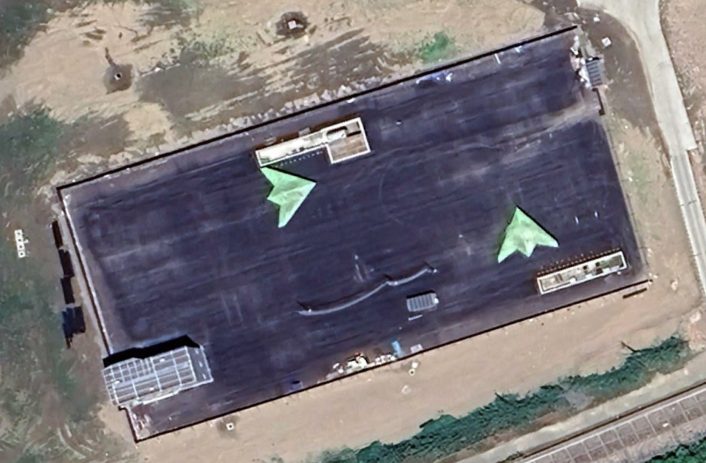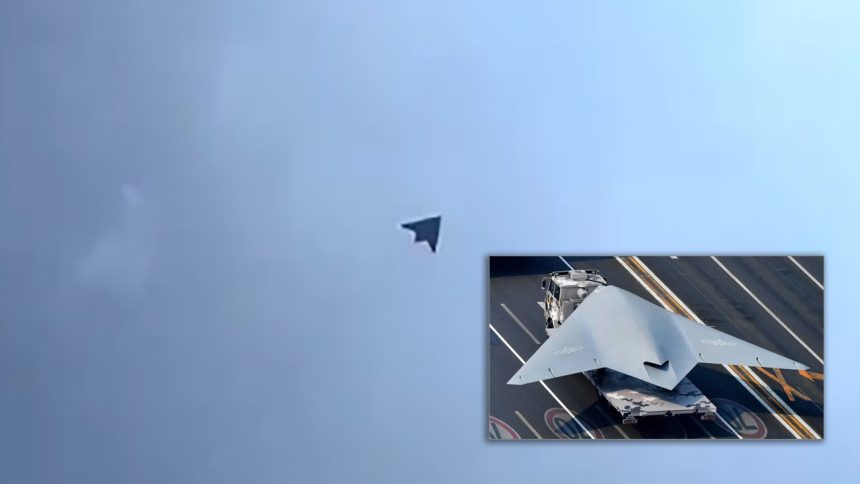Experts previously said China possibly intends to use the flying wing UCAV for carrier aviation, after satellite images of the GJ-11’s test models on a carrier flight deck’s mockup.
Just after The Aviationist reported the presence of a flying-wing test model at a known radar research site in eastern China and touched upon the GJ-11 Sharp Sword UCAV (Unmanned Combat Aerial Vehicle), the drone was spotted flying overhead in a video recorded by Chinese citizens. It was initially believed that this was the first time an airborne GJ-11 was captured on video.
However, Chinese military aviation analyst Andreas Rupprecht later mentioned that there are at least two more instances of the drone caught on video while in flight. The first one known was allegedly in December 2020, while the second was possibly in late 2023.
Apparently the new GJ-11 image (1) is not the first one showing it in flight and more and more images (2&3) are being posted … the one in daylight is allegedly from December 2020 taken somewhere around Nanchang and the one at noon is unknown. pic.twitter.com/7KEwKHTBk4
— @Rupprecht_A (@RupprechtDeino) August 23, 2024
Experts have long believed the drone has been flying, even if it was not captured in videos published online. Satellite photos of mockups of the GJ-11 on an aircraft carrier mockup led observers to call it a “near confirmation that a flying wing UAV/UCAV is intended for carrier aviation.”
This is near confirmation, that a flying wing UAV/UCAV is intended for carrier aviation (?GJ-11 derived, and likely already being tested).
J-15, KJ-600, J-35/XY, all had mockups here as well.
Interesting it seems to retain the planform of GJ-11, and not a cranked kite. https://t.co/ruF2stvcV8
— Rick Joe (@RickJoe_PLA) December 20, 2023
Developed by the AVIC (Aviation Industry Corporation of China), the GJ-11 Sharp Sword was officially displayed mounted on trucks in the massive military parade in Oct. 2019, celebrating the 70th anniversary of the PRC’s (People’s Republic of China) founding.
Chinese GJ-11 Sharp Sword UCAV spotted during test flight.
GJ-11 is notable for its stealth capabilities and advanced design, which includes a tailless flying wing structure.
Recent reports indicate that the GJ-11 is capable of operating from Type 075 amphibious assault ships. pic.twitter.com/n1dmJO7LS4
— Clash Report (@clashreport) August 23, 2024
Like the American X-47B or Russian S-70 Okhotnik, the GJ-11 has a top-mounted air intake for the engines, but bears a clear flying-wing design and not the cranked-kite wing configuration of the X-47B. The tailless configuration is consistent in both previous mock-up appearances and official unveilings, meaning AVIC has placed a high-premium on stealth. It also has a wide flat exhaust like the X-47B or the B-2 Spirit bomber.
Previous mock-up appearances
A mock-up of the UCAV was seen in satellite photographs on a full-sized carrier test facility in late December last year. This was followed by two GJ-11’s mock-ups seen on a test and/or training site on Changxing island in Shanghai in Jun. 2024.
Although the video is not very clear, judging from the wingtip shape, it looks more like a ground-based GJ-11 of PLAAF. https://t.co/uNxjX5zDIE pic.twitter.com/UByKhXFhPu
— Q (@foolsball) August 22, 2024
The War Zone observed that the mock-up was just a mile away from where a new class of Chinese amphibious LHD (Landing Helicopter Dock), the Type 076, with its uniquely large flight deck, is being constructed. Chinese military observers noted that the size and dimensions of this mock-up was much closer to the Type 076’s flight deck operating area, concluding that the GJ-11 is meant to operate from there. Prior to that it was unveiled at the Singapore Air Show in Feb. 2024.

Will the Chinese military induct it in service?
Screen grabs from an Oct. 2022 digital representation on CCTV (China Central Television) showed a J-20 flying with three unmanned wingmen, which were identified as GJ-11s. Whether this concept was a graphic designer’s personal rendition or some reflection of official PLA Air Force future plans for manned-unmanned teaming with its 5th generation stealth fighter is not clear.
It must also be taken into account that this appeared on state media and not unofficial social media accounts of Chinese citizens on Weibo, who also often function as plane spotters around many Chinese air bases. They also create fan-made art of Chinese defense programs and military aviation, which go viral and are subsequently debunked by independent researchers on the Chinese military. In other instances, the supposed programs simply never fructify.
中国军媒展示了歼20双座版操控3架攻击11无人机的CG pic.twitter.com/nGqrTbpY23
— lqy🇨🇳 (@lqy99021608) October 12, 2022
As mentioned earlier, aside from the fact that the J-20 and GJ-11 teaming graphic appeared on state media, the UCAV has also appeared as mock-ups on test sites replicating aircraft carriers, and test dummy models at drone bases. Additionally, scale models have also been displayed at the 2024 Singapore Air Show, meaning China might also export the drone to willing buyers after operationalizing it itself.
Un passage dans un reportage de CCTV-7 montre la possible collaboration entre un J-20 biplace et des #drones GJ-11 à faible observabilité.
La représentativité est à confirmer. pic.twitter.com/9Xy8Q8KQOO
— East Pendulum (@HenriKenhmann) October 12, 2022
Lastly, the drone was officially displayed in a parade in Oct. 2019 celebrating the PRC’s founding, which serves as direct evidence that the GJ-11 will be inducted at some point. Whether it would serve as a unmanned wingman for the J-20, possibly its two-seat variant or function as a UCAV flying from its LHD/LPD (Landing Helicopter Docks/Landing Platform Dock) remains to be seen.
Tactical use
If the naval version fructifies, PLA Navy planners would have to decide on the right mix of its Z-10 and Z-21 light and heavy-class attack helicopters for the aircraft inventory the ships would carry. Tactically, the GJ-11 would offer significant attritional capability for low to medium-risk reconnaissance-strike missions in the western Pacific, especially if the US and Allies (Japan, Australia) intervene.
It could conduct surveillance of the remote Japanese islands close to Taiwan’s northeastern waters, where Tokyo has moved surface-to-surface missiles. These could be the Type-12 anti-ship missiles. The GJ-11 offers options redundancy options for target identification through data-linking and reconnaissance
The drone could have a similar use in a Taiwan contingency for degrading Taipei’s tactical land targets like air defense sites and forward battlefield command and control centers.









